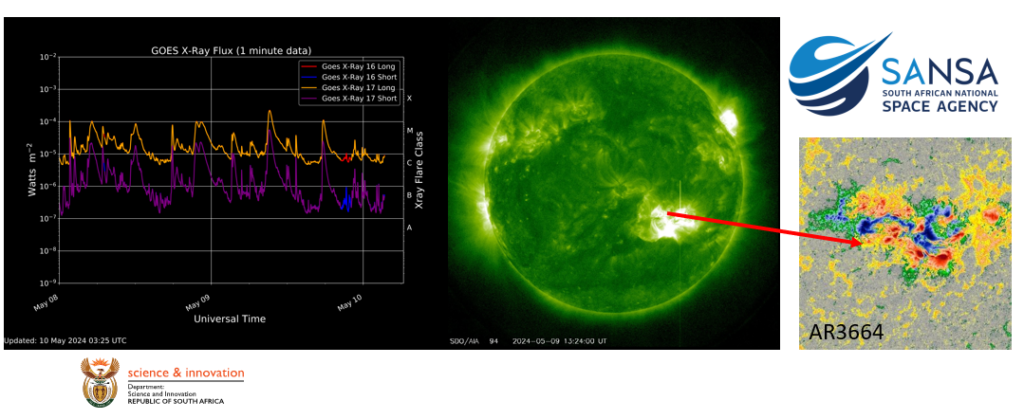
May 10, 2024
Space weather is caused by explosions on the Sun that can interact with the Earth’s magnetic field and upper atmosphere and disrupt our technological systems both in space and on the ground. Industries that rely on navigation and telecommunication services are at risk due to the adverse effects of space weather. In sectors such as the aviation industry, these disruptions can be catastrophic.
The South African National Space Agency (SANSA) launched its 24/7 operational Space Weather Centre at its facility in Hermanus in November 2022. This state-of-the- art facility operates around the clock to monitor and mitigate the risk of space weather on our continent. SANSA has been actively studying and forecasting space weather since 2009 and is the only accredited space weather centre in Africa.
This week has seen a major increase in activity on the Sun with several strong solar flares and coronal mass ejections (CMEs) erupting from the Sun and sent on a collision course with the Earth.
The African region experienced interruptions in high frequency (HF) communications due to two X-class flares and several M-class flares that were observed in the past 24 hours. Five categories — A, B, C, M and X — are used to rank solar flares based on their intensity. A-class are the weakest, while X-class are the most energetic. The impacts of solar flares are immediate due to the flare traveling at the speed of light and reaching Earth within eight minutes.
Several CMEs with Earth-directed components from most of the M- and X-class flares are expected to affect Earth. A CME is a cloud of charged particles from the Sun and can reach Earth between one and three days. The CMEs that were observed on 8 May are likely to reach Earth later today, Friday 10 May and into tomorrow, Saturday 11 May 2024.
A G1/Minor up to G3/Strong geomagnetic storm is forecasted to impact Earth due to the likely combination of these CMEs upon arrival. There is a slight chance that the geomagnetic conditions will reach G4/Severe storm levels on 11 May. These may impact the performance of navigation and communications applications.
The sun has an eleven-year solar cycle going from solar minimum to solar maximum. We are expecting to reach the solar maximum in 2025. As we move closer to solar maximum, we anticipate an increase in the frequency of space weather events. SANSA will continue to monitor and work with its clients and stakeholders in government and private sectors to ensure that they have access to real time information to best protect their assets.
You can follow daily space weather updates at https://spaceweather.sansa.org.za/





